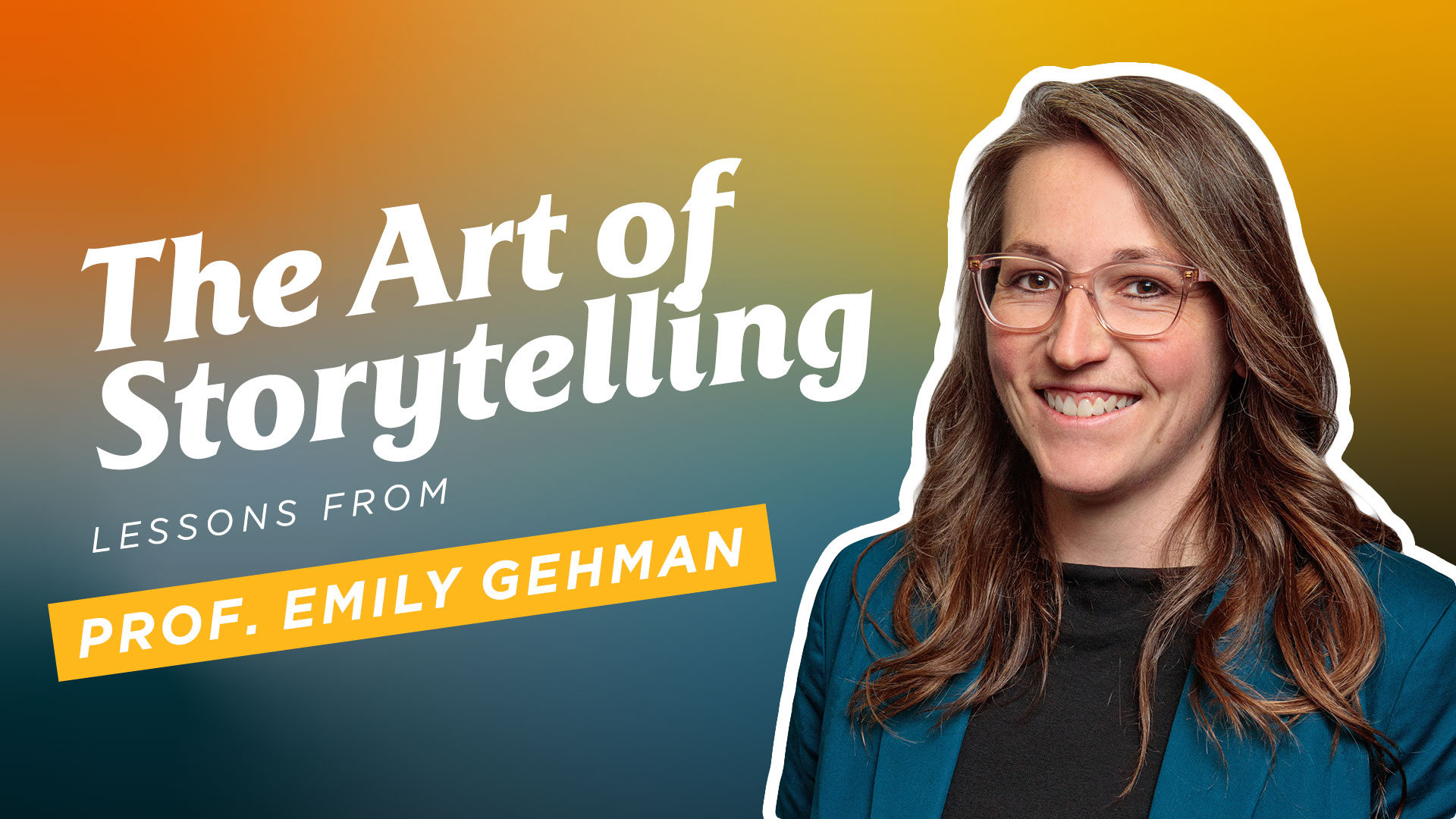By Prof. Emily Gehman, Assistant Professor of Communication & English
As editor of Journey Magazine and a communication professor, I’ve spent years teaching students the craft of storytelling. I reach out to alumni, conduct interviews, write stories, and deploy student writers to teach them these essential skills. Whether you’re writing fiction or nonfiction, there are fundamental principles that separate compelling narratives from forgettable ones. These are hard skills and soft skills that every storyteller needs in their tool belt.
Every Story Needs Conflict
At its core, every story revolves around conflict. It falls into one of three categories: man versus man, man versus God, or man versus nature. Every story you ever watch, read, see, or observe is going to have conflict. Without conflict, you don’t have a story, you have a documentary.
Sometimes that conflict isn’t always visible right at the start of the story or the interview. You kind of have to dig for it a little bit. Once you identify the conflict, that’s going to drive your details and it’s going to drive you to that climax. The solution, the resolution to that conflict, is going to be toward the end of your story. And that’s how you’re going to land it.
Character Is Everything
Story is character in action. Plot is character in action. You’ve got to establish who your character is, do a little bit of setup, do a little bit of background details. You want your audience to be cheering for your hero all the way through the story.
Pixar has this boiled down to a science. You can look it up, it’s called the Pixar way. It’s like seven steps to a good story. They’re not wrong. They’re making some good money on their Pixar way storytelling. And it is generally that way. It’s an art, more of an art than it is a science.
The Power of Details
Good concrete details push the story forward. If a detail does not push the story forward, you don’t need that.
Anton Chekhov is famous for Chekhov’s gun, Chekhov’s pistol. He was a Russian playwright. He says, if you hang a pistol on the wall in act one, that has to be fired by the end of act two. You can’t put a pistol on the wall in a play and it just be hanging there, because people are going to be looking at the pistol going, when’s that coming off? His point is: don’t include a detail in the story if it’s not going to move the story forward.
With fiction storytelling, you have all the creative control. You get to decide what you want in there. In nonfiction storytelling, you’ve got a set of data and you are choosing which details to include.
Say I’m going to tell a story about an adoption. I’m going to tell you about the couple that can’t have children, that really want to have children. All they’ve been doing for the last however many years they’ve been married is trying to have children. I’m going to set up that conflict and that pain, and then somehow it’s going to resolve.
Every Detail Must Earn Its Place
Well, they might in the interview talk about their red couch that they really, really love. That’s a concrete detail. “I love this red couch. It’s soft. You can take a really great nap on it. We just really love this red couch.” But the red couch has nothing to do with their adoption story, unless the red couch has something to do with the adoption story. Maybe this was given to them by their cousin, and now their cousin calls and says, “I need someone to take care of my baby.” Then that’s an important detail. Typically the red couch isn’t going to be an important detail.
You have to have a discerning view, a discerning lens. You’ve got your dataset. You’re not making anything up in nonfiction storytelling, but you’re including details that push the story forward and you’re not including details that don’t matter.
Show, Don’t Tell

Anton Chekhov again, with his wisdom, says: “Don’t tell me the moon is shining. Show me the glint of light on broken glass.” I can’t say it any better. You could just write “the moon is shining,” or you could show that there’s broken glass and the glint.
You do have to be in tune with your gut. Do you feel good about saying this, or are you making it up? Is it a little bit too sensational? I think a lot of writing particularly comes with learning your gut. And that’s an art, not a science.
There’s the authenticity of coming from a different perspective, your unique perspective. You’re giving whatever gift, talent, whatever God has given you in whoever you are, and providing that for others to be able to read and say, “Yeah, I’m getting kind of a glimpse into this person’s life, into their mind or their perspective.”
Acknowledge Your Bias
For the Journey, I’m a biased writer. I work for Grace Christian University. I’m going to stay within the dataset. I’m not going to sensationalize it. I’m going to tell about the good things that Grace did in this person’s life. I’m not going to tell them about the really long phone call they had with financial aid, trying to get everything figured out. I’m not going to tell them about how expensive their textbooks were, partly because it’s not a helpful detail, but also inherently, yes, I’m a biased writer.
Every writer, every reporter is going to have some bias, and a reader needs to know that going in. As reporters, we do our best to stay unbiased. But at the end of the day, it’s still going to be true. I’m the managing editor of Journey magazine. I’m going to write good things about Journey. I’m not going to write the bad things about Grace.
There is a modicum of that. But I mean, I sleep pretty well at night. I don’t lie on the things. You have that gut check.
The Ultimate Gut Check
A really good practical way to check yourself, for any writer to check themselves, especially in a journalism thing: finish the story, send it to the storyteller, send it to the person who shared that story with you.
If they say, “Yeah, this is great,” excellent. If they say, “Well, yeah, but this one thing you got wrong,” they will tell you to fix the story. That is a helpful check because then you know that they’re happy with it. They’ve told the right story and feel good publishing it.
Storytelling requires developing your instincts, understanding narrative structure, and maintaining integrity in your craft. Master these principles, and you’ll create stories that resonate and endure.







